Managing For Quality: ISO 9000 & Beyond
By
Ian Harris, Professor Michael Mainelli and Geoffrey Rutland
Published by
QUALITY - WHO CARES?
The short answer is “everybody”, if you define delivering quality as meeting the customer’s requirements. The problem has been defining what quality means to each customer. Quality in this sense is not necessarily sophistication, hi-tech or Rolls-Royce; quality is appropriateness for the requirements, or fitness for purpose. Quality management, i.e. managing for quality, must therefore cover the whole spectrum of management activity designed to ensure that customers’ requirements arte identified and met.
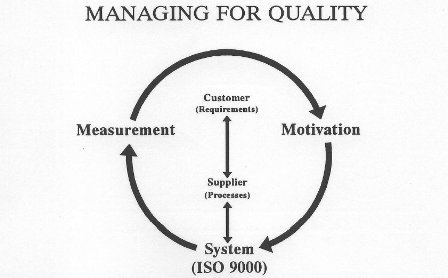
From these requirements, a supplier can build a system of policies and procedures (a Quality Management System, or QMA), so that people know what is expected of them. There has to be commitment to quality from the highest level in the organisation, in the form of resources and overt support, providing motivation at all levels. The system needs to include controls in order to make sure that things actually happen. And, to make sure that the process is effective, and to make improvements, measurements must be made. Once the QMS has settled into the business way of life of an organisation, motivation should be self-reinforcing, so that people using the system can identify improvements and see them implemented. And so the cycle continues. A QMS, if properly implemented, can go a long way towards setting in place a framework for achieving quality throughout the organisation.
External assessment or not?
A Quality Management System may or may nor be assessed against ISO 9000, but a growing number of organisations want to put themselves through the rigours of external assessment, both to prove to their customers that they have been independently assessed, and as a discipline to ensure that the system continues to be effective.
Pressures for a formalised Quality Management System
There are three main pressures to implement a formalised Quality Management System:
- Customer Pressure – A growing number of organisations, particularly in the public sector and large corporate organisations, are demanding that their suppliers have or are going for ISO 9000. Suppliers without ISO 9000 are at a definite disadvantage;
- Competitive Pressure – If you have ISO 9000 and your competitors do not, you have a powerful differentiating factor. On the other hand, if others in your sector have ISO 9000 and you do not, you are immediately at a disadvantage;
- Internal Efficiencies – Organisations are having to reassess their internal efficiencies and cost base, especially coming out of a recession. The process if achieving ISO 9000 helps identify and implement improvements. ISO 9000 also provides a firm basis for a wider Total Quality Management (TQM) programme.
Benefits of ISO900
We recently conducted a survey of service sector organisations who had gained ISO 9000 registration. The results show that nearly three-quarters (74%) feel that ISO 9000 is beneficial, both to them and their customers. Some key figures:
- 74% of survey respondents felt the benefits of registration outweigh the costs;
- 66% claimed improved staff performances, 57% noted improved attitude to customers;
- Internal benefits achieved: 78% noted improved consistency, 73% improved efficiency, 60% reduced rework / waste;
- External benefits achieved 68% felt that quality of service had improved and 54% had received positive feedback from their customers, while only 11% had received negative feedback.
The conclusion seems to be that implementing a Quality Management System and obtaining ISO 9000 registration is an important step towards improving quality throughout the service sector.
BUILDING A QUALITY MANAGEMENT SYSTEM
Elements of a Quality Management System (QMS)
The QMS documents how an organisation meets the requirements of ISO 9000. Typically the QMS elements will cover:
Policy (the commitment to quality) – the scope of the QMS, management responsibilities for quality, and the QMS structure put in place to deliver quality;
Infrastructure (having the right resources) – all the things you need to have in place before even talking to a customer: recruitment, training and appraisal of staff; design of products or services; equipment and facilities; control of suppliers and subcontractors;
Service Delivery (doing it right, consistently) – this is the core of an organisation’s QMS, and should be based on the way that a service is typically delivered. For example, in a software organisation it could be a system development lifecycle; for a professional firm, it might cover the method of obtaining and agreeing instructions, planning and monitoring the actual work, and the delivery of the report or advice; for an internal support department, it might cover the process for developing and agreeing service levels with client departments, and methods of monitoring and reporting performance against levels. Service delivery procedures should also make reference to the relevant standards and guidelines, whether legal requirements, industry codes of practice, or in-house standards.
Internal Quality Audit (Checking you did it right) – how you know that you are doing it right, including what will be audited, who will do the auditing, and what action will be taken if problems are found. This covers both fixing the problem (corrective action) and trying to ensure it cannot happened again (preventive action).
The ISO 9000 QMS implementation process
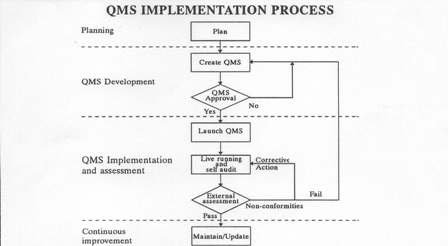
Planning - Before making the decision to go ahead you should be fully aware of the implications. You should:
- Evaluate the current situation, including the stage and usage documentation;
- Document your requirements for a QMS, together with any additional requirements for ISO 9000 and taking into account any guidelines or sector schemes, such as TickIT for the software sector;
- Identify issues, such as whether to register one site or all at once;
- Identify the likely benefits, costs, timescales and risks, and quantify them where possible.
At this point you cab decide how best to proceed.
QMS Development – The first step is to develop the detailed documentation required for the QMS, in the form of manuals or handbooks. This will involve a drafting and review process which should involve staff at several levels in the organisation. It is also important at this stage to identify a certification body appropriate to the needs of the organisation. Once approved by senior management, the QMS should be submitted to the selected certification body for approval. Once finalised and approved, your QMS should satisfy ISO 9000.
QMS Implementation, Live Running and Assessment – The QMS is launched. Every member of staff must be trained and issued with the relevant QMS documentation. During a live running period for several months, they will have to use the QMS. Internal quality audits should also be carried out. All stages of service delivery should be covered during live months. External assessors will then carry out an extensive audit of your QMS and your compliance with it. Most assessments result in a number of minor non-conformities and, subject to these being corrected, you will be recommended for registration to ISO 9000.
Continuous Improvement – Once your certificate has arrived, your organisation will be listed in the DTI’s QA Register. Once registered, you will have to maintain the QMS, update it as required, train new staff, continue internal quality audits and undergo periodical surveillance visits by certification body to ensure that your QMS is still effective and that you are still adhering to it. Registration is, in effect, the start of a continuous improvement cycle.
It’s your system
The ISO 9000 registration process, if properly planned and implemented, should result in a QMS which serves you, rather than vice versa. It is your system and, as such, will evolve. A good QMS should be seen as a means of continuously improving the way you operate, to the benefit of your organisation, your customers and your staff.
BEYOND ISO 9000- TOWARDS TOTAL QUALITY
Benefits and Limitations of ISO 9000
Achieving ISO 9000 represents a major step forward for most organisations. Typically the benefits to be gained are:
- Lower cost of sale – many organisations find that as a result of better planning and review procedures, they incur fewer unplanned overruns in delivering their services, thus reducing their unrecoverable costs;
- Improved effectiveness – existing processes are more effective, and new ones have been introduced;
- Improved consistency – for many organisations, consistency has previously been lacking;
- Documented procedures – procedures are now (better) documented, so it is easier to be clear what needs to be done, when and by whom, and to monitor progress;
- External benefits – users or customers should now start to perceive a better service.
ISO 900 can be achieved with some or all of the benefits described above although there are also limitations. If not enough effort has gone into making the QMS usable and practical, or no effort is made to build on ISO 9000 registration, an organisation can be faced with:
- Costs not fully quantified – the costs of implementing a QMS often are known. What is usually not known is the continuing costs of having and maintaining a QMS, particularly as a basis for continuous improvement;
- Not necessarily more efficient – ISO 9000 does not address the question of efficiency. Most organisations actually seem to improve internal efficiency, but it is mostly through codifying current processes, not by re-examining the processes themselves in detail;
- Limited flexibility – a QMS written to achieve ISO 9000 with the minimum of effect is likely to be inflexible in dealing with new or changed areas of business;
- Bureaucracy – a QMS developed without the user in mind will sit in shelves and gather dust. Similarly, people will ignore, or finds ways of avoiding, a QMS with excessive form-filling;
- Internal focus – developing a QMS is a mainly internal process, creating a QMS with an internal focus. The user or customer can feel ignored;
- Process, not content – ISO 9000 itself does not guarantee the content (that is, inherent quality) of what is produced, merely that the process of producing it satisfies a standard and that the organisation follows its procedures.
ISO 9000 registration can be summed up as “Assured Quality”, i.e. a customer can be more confident that an organisation with ISO 9000will deliver (to timescales, budget, specification and cost) than one without ISO 9000. However, in a competitive marketplace, ISO 9000 becomes the minimum that any credible supplier has to have. A well designed QMS is a good starting point, but to keep on improving requires moving up a gear to drive towards the goal of total quality.
Moving Beyond ISO 9000
TQM means different things to different people, and even TQM gurus disagree. However, it is clear that TQM is a continuing process, and you cannot ‘be’ or ‘get’ Total Quality. It is more like a never-ending game of snooker or chess, where you do not just play the current shot or move, but continually position yourself for the next one, and the one after that. Two key features of TQM are Cost of Quality and External Focus, both entailing the involvement of people throughout the organisation.
Cost of Quality
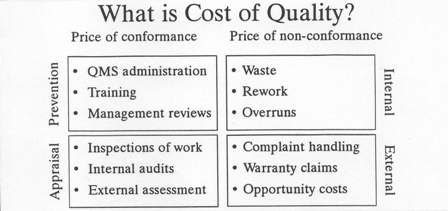
Cost of Quality has two main elements: Price of Conformance (POC) is the cost of trying to make sure that nothing can go wrong; Price of Non- Conformance (PONC) is the cost when things do go wrong. POC is further split into Prevention, to avoid problems happening and Appraisal, to trap problems before they get out. PONC is split into Internal and External costs. The table above gives examples of each category.
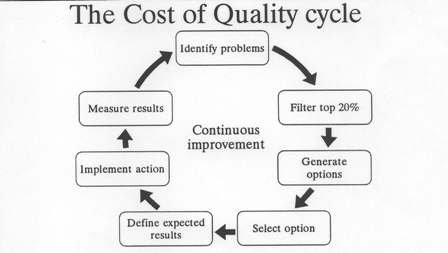
The steps in the Cost of Quality cycle are:
- Identify the perceived problems
- Filter out the top 20% - the critical few (80-20 rule)
- Generate options to deal with the top 20%
- Select the most appropriate option
- Define the expected results
- Implement the action, i.e. do it
- Measure actual against expected results
Then start all over again! Most costs of quality can be easily measured or a good guesstimate made. Later, accuracy can be improved, but only if it actually helps. Getting Cost of Quality right can be described as “Efficient Quality” – building on Assured Quality to deliver consistency efficiently, then continuously improving.
External Focus
Building an External Focus means a shift from your own internal viewpoint towards that of your customers and potential customers – after all, they are the reason you are in business. This can be directly, eg by project planning and review, or indirectly by customer satisfaction surveys, perception surveys (non- or potential customers), success/failure analysis (why you did or did not get the contract). Additional input, such as R&D and best practice benchmarking, can help you deliver not only what is explicitly specified, but what is subconsciously expected, or even not expected. Total Quality is a journey, not a destination. Getting the External Focus right, and continuously striving to refine it, means that you are well on the Continuous Improvement route to Total Quality.
Continuous Improvement
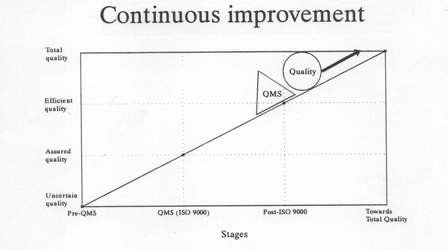
The figure above shows this Continuous Improvement process. In the period before a QMS is implemented, an organisation is in a state of uncertain quality, i.e. there is limited assurance of standards being met. As the organisation implements a QMS it reaches a level of assured quality. The QMS is shown as a wedge, keeping quality from slipping to a lower level and used to drive quality upwards. Moving beyond ISO 9000, the organisation looks at measuring and improving its systems, processes and procedures to achieve efficient quality, documented in the QMS. Developing an external focus used the QMS as a starting point for other initiatives, looking outside the organisation and moving towards Total Quality.
CASE STUDIES
Futures and options brokers – back office
This client is the largest firm if brokers in London. They wanted to achieve ISO 9002 for the Operations Department (back office) which, once a trade is struck, is the area that most affects their clients’ perception of quality of service. We were commissioned to help plan, develop and implement an appropriate Quality Management System (QMS). The key was that the QMS had to be designed to fit working practices, with the minimum number of additional procedures to satisfy ISO 9002.
The manager of the Operations Department was heavily involved in the project from the start. The only major change to operational working practices was the introduction of a simple checklist for each section to ensure that the key actions were being carried out each day. We helped draft non- operational procedures, and also assisted with the evaluation and selection of a suitable certification body.
Implementation started with a series of launch meetings cum training sessions so that everyone in the department was clear in their responsibilities and the requirements of the QMS. In fact, most people had been involved in the department process, so there were no surprises.
We supported the client during several months of live running and helped set up the internal quality audit programme. Our client became the first organisation in the sector to gain ISO 9000 registration for any of its services, and is using the QMS as a firm basis for continuous improvement into the future.
Software implementation consultancy
Our client is the European professional services arm of a US-based banking software company. They provide implementation consultancy, configuration and support to their clients, who have purchased the company software.
They decided to obtain ISO 9000 registration as a first step in a longer term quality programme, mainly to improve the efficiency and effectiveness of the services they provided. We assisted then with a detailed plan for the development and implementation of a ISO 9000 Quality Management System (WMS), identifying the costs, resources and timescales involved in the programme.
Working closely with the full-time client project manager we helped develop the necessary QMS procedures, based ion the TickIT guide and the client’s existing lifecycle mythology. We also helped them to select a suitable certification body to review and approve the QMS in principle.
Once the QMS was approved in principle, we developed training material, assisted with the launch, and supported the project manager during live running, self audit and the assessment. With a small number of nonconformities cleared, our client was registered to ISO 9001 under the TickIT scheme at the first attempt.
Following the success of the initial project, our client retained us to help develop the necessary additional procedures to widen the scope of registration to include development of one if the company’s key software products.
CLIENT BASE
We provide quality consultancy advice to clients in service-oriented organisations. The following list shows clients we have worked with in this area, designing, developing and implementing Quality Management Systems to ISO 98000 standard.
- Software implementation consultancy
- Market research organisation
- Consultancy actuaries
- Chartered surveyors
- Banks
- Insurance brokers
- Financial advisors
- Future brokers
- Internal shipping
- Computer manufacturers
- Direct marketing
- Power generation
- International telecommunications
- Charities
- Central Government
- National, government-sponsored council
- Local authorities